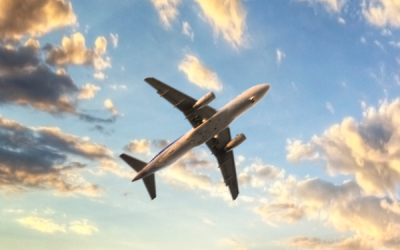Sustainable aviation fuel (SAF) and what it means for the future of travel
- Reduces greenhouse gas emissions by 80%
- Other environmental benefits include improving air and water quality by lowering emissions of sulfur oxides (SOx) and nitrogen oxides (NOx)
- A boost to the farming community as they grow the biomass crops used in SAF production
- Improves aircraft performance
The call for sustainable solutions in aviation is more crucial than ever, given the unprecedented gravity of climate change.
But with Sustainable Aviation Fuel (SAF) costing up to three times more than conventional jet fuel, it poses a real challenge to airlines seeking a seamless transition to SAF compared to other fuel alternatives.
The future of air travel is undeniably linked to the need for a greener approach and SAFs are a critical component of the industry strategy for reducing carbon emissions.
The aviation industry can make big steps towards sustainability by putting the focus on using SAFs which significantly reduce carbon emissions in both current and future aircraft flights.
And that was really highlighted when Virgin Atlantic was given approval from the Civil Aviation Authority to make the world’s first 100% SAF flight over the Atlantic on November 28.
It was a significant milestone for the industry – ground tests had been a success with a Rolls Royce Trent 1000 engine, using a SAF blend from Air bp and Virent.
The Boeing 787 flight – Flight 100 – from Heathrow to New York’s JFK airport used 60 tonnes of the SAF and highlighted how the industry needs to work together in a bid to meet the industry’s target of 10% SAF by 2030.
After touchdown, Shai Weiss, CEO, of Virgin Atlantic, said: “We did it. Flight100 touched down in New York. Flight100 has proven that if enough SAF is made, we will fly it. SAF is a safe, drop-in replacement for fossil derived jet fuel. Compatible with today’s engines, airframes and fuel infrastructure.
“This is our call to action. In the UK, the Government leaned in by launching this competition to fly Flight100, which now means we must move quickly to drive a policy that will create a UK SAF industry.
“The US government have also taken action to match their own ambition on aviation decarbonisation. President Biden set out a SAF Grand Challenge in 2021, for 3 billion gallons of SAF by 2030, and through the Inflation Reduction Act the US government is committing $billions to stimulate private investment into the US SAF industry.
“Indeed, our first SAF deals were made in the US, where we agreed delivery of 70 million gallons of SAF from GEVO – alongside our partners at Delta – to ensure we hit our commitment of 10% SAF by 2030. And we’re partnering with innovative companies like Air Company, developing technology to convert carbon directly into SAF to achieve emissions reductions.
“Now, it’s time to work together to lead the way to a more sustainable future. That isn’t just about setting ambitious targets but taking action – and we welcome the close collaboration of our friends and partners on both sides of the Atlantic.”
Emirates is set to implement SAF for departures from Singapore and Amsterdam, contributing three million gallons to these crucial airports.
Among other airlines already embracing SAF are British Airways, Turkish Airlines, Qantas, United, LHG, Vueling and AF KLM.
So things do seem to be heading in the right direction.
And Clive Wratten, Chief Executive of the Business Travel Association (BTA), who was on board the flight, said: “Virgin have proved fully fuelled SAF flights can happen now we need deeper collaboration between the aviation industry, the supply chain and governments to have supply reach critical mass.
“Let’s not lose momentum, let this flight galvanise everyone to make every flight 100% SAF a reality.”
What is SAF?
SAF is an alternative fuel derived from renewable sources that is said to reduce emissions from air transportation by up to 80%, fundamentally reshaping aviation into a less carbon-intensive mode of travel.
Top of FormAs SAFs incorporate by-products like animal fats, the availability of such fats is limited unless, meat production upscales significantly.
However, this reliance on animal fats in SAF is unsustainable due to their scarcity, impacting other industries such as soap and pet food.
Consequently, suppliers in these sectors may be compelled to shift to palm oil, thereby posing challenges within their respective domains.
SAF is positioned as the frontline solution against climate change, with the UK domestic aviation sector setting a target to achieve zero net emissions by 2050.
Despite it being a key component in its role to meet ‘Jet Zero’ goals, the adoption of SAF faces challenges due to its high cost and limited global supply.
How will this impact business travel?
SAF will impact business travel through influencing the travel experience as well as the broader landscape.
It’s not just about the journey, its about making a real impact. It provides an opportunity for companies to align their operations with sustainability goals therefore enhancing their market position and meeting the expectations of environmentally-conscious clients.
Understandably there will be a short-term impact, however, in the long term, companies will gain a positive brand image and increase their competitiveness in the market.
Firstly, the cost implications are that it’s more expensive, meaning businesses will be facing higher travel costs.
Balancing growth, driven by increasing demand for air travel, and trying to reduce its environmental impact, will prove a challenge for the travel industry.
A key impact is businesses in the modern day are focused on environmental sustainability meaning the use of SAF aligns with the corporate responsibility goals people advertise, therefore showcasing their commitments to reducing the carbon footprint associated with their travel operations.
Airlines like Lufthansa are enticing customers to use their sustainable flights, by offering free wi-fi and additional incentives to customers.
This strategic approach aims to encourage customers to travel sustainably through making greener choices.
For businesses who operate with tight travel budgets, the financial implications of airlines who implement SAF can pose a burden, making it challenging for businesses to effectively manage travel budgets.
Solutions?
The aviation industry is at a crossroads, figuring out how to boost SAF use because of its significant carbon emission reduction in comparison to current fuel use.
The European Union is pushing for a gradual increase in SAF usage.
They want fuel suppliers to ensure 2% of fuel available at EU airports is SAF by 2025, with that figure increasing to 6% in 2030, 20% in 2035, then 70% by 2050.
It’s not just a trend, businesses are advised to set aside a reserve budget for the adoption of SAF, supporting global sustainability goals.
According to Forbes (2023), a gallon of SAF emits between 50 and 80 per cent less carbon dioxide than conventional jet fuel.
Top of the agenda for governments and industries are to address the current high costs of SAF and are teaming up to offer incentives and subsidies to ensure these sustainability targets are hit as soon as possible.
Just last week, the UK government awarded £53 million in funding to nine projects to produce more sustainable aviation fuel (SAF), including British Airways’ Project Speedbird production facility.
This is just the beginning as the aviation industry is expected to double to more than eight billion passengers by 2050.



